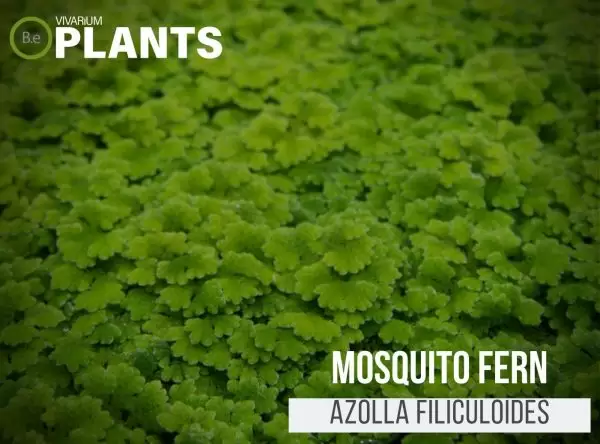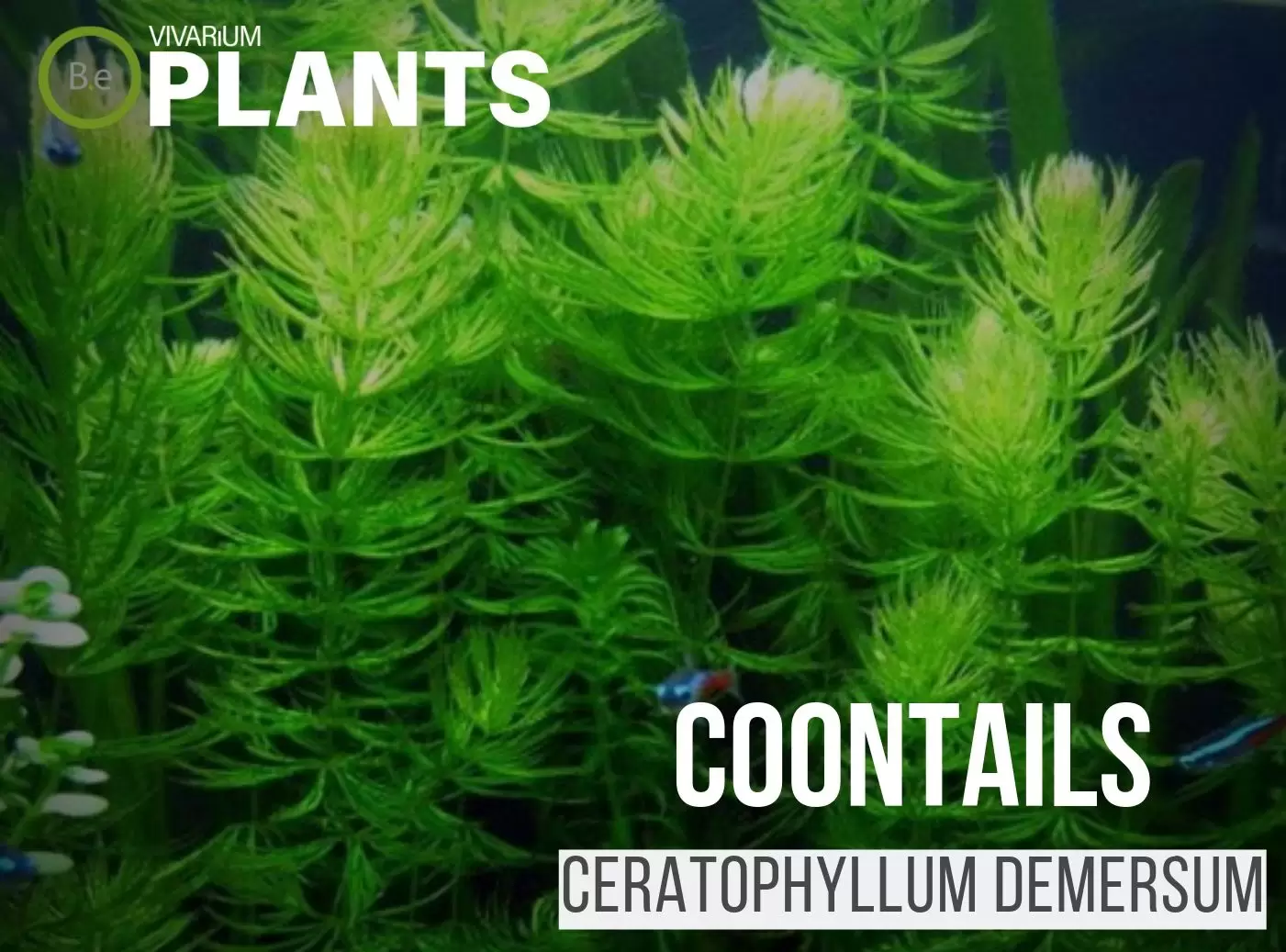Azolla filiculoides is a species of fern in the Salviniaceae family. Commonly referred to as Mosquito Fern, it is part of a genus of seven species of aquatic ferns. It is a rather fast-growing aquatic plant that can be seen free-floating in still or slow-moving freshwater.
While Mosquito Fern starts off small in size at barely ¼ inch in diameter, it can double its size in a matter of days. For this reason, it is known as a quite hardy and dense matting plant.
| Quick Stats: | |
|---|---|
| Scientific Name | Azolla filiculoides |
| Common Name | Water Fern, Large Mosquito Fern, Red Water Fern |
| Family Name | Salviniaceae |
| Habitat | Freshwater, Temperate/ Tropical Regions |
| Temperature | 59°F to 79°F |
| Height | 1 inch |
| pH | 4.5 to 7.0 |
| Lighting | Bright |
What Is Mosquito Fern?
Mosquito Fern (Azolla filiculoides) is a very interesting plant to enhance a thriving vivarium. Aside from basically taking care of itself, this fern can be highly beneficial to its environment as well as other plants. Many hobbyists use this vibrant plant as a way to decorate their tanks.
Mosquito Fern’s floating nature gives any enclosure a versatile and dynamic look. This article will provide a complete guide to the plant’s care and important details.


Mosquito Fern Facts
Besides Mosquito Fern, Azolla filiculoides are also referred to as Water Fern, Large Mosquito Fern, and Red Water Fern. Due to its rapid and mat-type growth, it is an excellent plant for supplying shade and protection over large areas of water.
In fact, Mosquito Fern earned its name due to its ability to shield habitats from mosquitoes. The thick, living carpet repels and prevents mosquitoes and many other insects from penetrating through and laying their eggs in open water.
Azolla filiculoides are normally cultivated for their agricultural value as well as their decorative use. This fern has the unique ability to pull nitrogen from the air. There are photosynthetic bacteria, called Anabaena Azollae, that live within the leaves of the fern.
These bacteria have the ability to turn atmospheric nitrogen into nitrate fertilizer. When the plant dies, the nitrate fertilizer is released and can be used by other surrounding plants.
Description
Mosquito Fern is a very small aquatic plant that often grows less than 1 inch long. Although it is not duckweed, it has similar characteristics and features. This fern’s leaves grow in two rotating rows on each side of the stem.
The thick and quilted look of the leaves hides the plant’s stem, which has a single root growing from it. A series of tiny scales growing from the leaves is what gives the aquatic fern the ability to float on the surface of the water.
Much like duckweed, Mosquito Fern will vary in color depending on its environment and age. Newer leaves that have recently sprouted are often bright green and as they begin to age they will turn a reddish/pinkish color.
Habitat
Mosquito Fern is a species of Azolla that is native to tropical and temperate regions. It was mostly found in the Americas as well as most of the old world including Australia and Asia.
This aquatic fern does not do well in cold temperatures and will usually die back in cold winters, only surviving by the method of submerged buds. Azolla filiculoides prefer slow-moving water and can be seen growing in ditches, ponds, wetlands, rivers, channels, and water reservoirs.
Unlike most ferns, this floating plant can survive and do well in sunny to shady locations of water. These locations provide the perfect temperature range for the fern to thrive ranging between 59 to 79 degrees Fahrenheit.
Although the plant is the most frost/cold tolerant of the Azolla species, it will die at temperatures below 5 to 14°F. In fact, Mosquito fern can survive encasement in ice for at least one week.
pH Preference
Another interesting quality of Azolla filiculoides is its ability to grow in a rather wide range of pH levels. It can survive within a water pH range of 3.5 to 10.
This means that as long as the water is not highly alkaline, the fern will continue to propagate. For optimal growth and cultivation, Mosquito Fern should be provided with a pH range of 4.5 to 7.
Vivarium Type
This type of fern will do great in a variety of vivarium types. When deciding if rather or not to use this floating fern in a particular type of enclosure, make sure to go with setups that have water features. Here are recommended vivariums Azolla filiculoides will do well in:
- Paludariums – Half aquatic/ half terrain-based enclosure.
- Ripariums – Mostly aquatic-based enclosures with some terrain features present.
Vivarium Placement
As mentioned before, Mosquito Fern is s fully aquatic and floating fern. Therefore, the plant will not prosper or survive in dry environments. Avoid placing the plant above ground where there isn’t a sufficient amount of water. Since it is a floating fern, it will also not do well if fully submerged. Azolla filiculoides’ roots will grow underwater, while its leaves remain in the open area.
Substrate
Floating ferns are generally substrate-less plants. Mosquito Fern is not the exception when it comes to this. This fern will not need to attach itself to any surface and will grow free-floating in the water.
For this reason, there won’t be a need to provide a substrate of any type. As long as the water parameters are appropriate and there is enough lighting, Azolla filiculoides will grow without an issue.
Lighting
As far as lighting goes, Mosquito Fern will thrive in sunny to partially shaded areas. For the most part, however, this floating fern prefers to be in direct sunlight. When attempting to recreate a natural habitat inside a vivarium, providing aquarium lighting that is close to sunlight will be the best option.
LEDs and full-spectrum/UV lights are usually the easiest and most successful way of creating a sunny day. If the vivarium will not be using any artificial lights, the best option will be to place the vivarium under a well-lit and unobstructed window.
Buy Mosquito Fern
When looking to purchase Mosquito Fern, there are a few key indicators you should look for. Buying the best quality plant will help give you the best shot at growing the fern successfully. The fern should be snail free along with any other type of pest.
The source of Azolla filiculoides will usually be sold in small clumps, ready for you to propagate. The batch should arrive fairly moist and with vivid colors. Try to stay away from sources that provide dried-out or dull-looking plants.
Click the image below to find out more about the current price and other relative info:




Mosquito Fern Care and Propagation
Mosquito fern is a pleurocarpous plant, which means it grows out instead of up. This and its rapid growth is what allows the fern to form a thick mat over the water surface it is growing on. Like most other ferns, Azolla filiculoides uses small shoots with spores on the tips as a way to multiply and spread.
Excess removal and proper upkeep will be an absolute necessity with this fern. It is technically considered an invasive plant and will completely cover all available water surfaces if allowed to grow freely. Doing so can deprive fully submerged plants of required light as well as clog up filtration systems.
How to grow
The quickest and easiest way to reproduce Mosquito Fern will be through the process of division. The original or parent plant should be taken and placed into separate smaller pieces. Then, simply spread out the new parts to allow new growth to begin.
This fern barely needs time to establish itself as it spreads so rapidly. All it needs is the right water parameters and bright light, and before you know it you’ll need to start removing parts of it.
Watering
Mosquito Fern is an aquatic plant and will remain partially submerged at all times. Therefore, it will most likely not require any additional watering. However, an important factor to keep in mind for a healthy plant is the proper water flow.
This free-floating flora does best in standing water or very slow-moving water. Humidity levels should be kept high and reflect those of a tropical rainforest. If the plant is left in a dry environment for too long, it will not survive.
Plants Similar To Mosquito Fern
Even though some hobbyists enjoy sticking to a specific theme when building an enclosure, that does not mean that only one type of plant must be used. Adding diversity and versatility is crucial to creating a captivating vivarium.
Mix up the look of your vivarium with different flora that can easily co-exist in the same types of environment. Not only will it be more pleasing to the eye, but it will also make the tank look more realistic.
Furthermore, if for some reason you are having a hard time getting your hands on this plant… Here are some other options that may do well with or in the place of Azolla filiculoides:
Conclusion
Overall, Mosquito Fern can be a great addition to your vivarium. It is quite an interesting choice of aquarium plant to use in an enclosure. Aside from its rapid growth, easy maintenance, and environmental benefits, this fern also offers a hint of color to otherwise all-green scenery.
It can help dress up and accentuate empty water spaces, while also helping the animals and other plants living in the enclosure. Have you ever used Mosquito Fern in one of your setups? If so, what was your favorite characteristic of the plant?
Frequently Asked Questions
Yes, Mosquito Ferns can be considered an invasive species. They can outcompete native ferns for light, moisture, and nutrients and can crowd out aquatic plants. This can have a negative effect on local ecology and water quality. ponds, swamps or other bodies of water.
Mosquito Fern earned its name due to its ability to shield habitats from mosquitoes. The thick, living carpet repels and prevents mosquitoes and many other insects from penetrating through and laying their eggs in open water.
Yes, Mosquito Ferns can help to repel mosquitoes. Mosquito Ferns contain various anti–insect compounds and have been shown to reduce mosquito populations in some areas. The fern‘s ferny foliage is thought to repel adult mosquitoes, while its roots trap larvae and provide food for fish and other aquatic animals. Mosquito Ferns are often seen as a natural, eco–friendly solution to controlling mosquito populations in bodies of water.
Mosquito ferns (Azolla filiculoides) can be controlled by using physical or chemical control methods. Physical control methods involve hand–weed removal or clipping. Chemical control methods include spot–treatment with aquatic herbicides that are labeled as safe to use in water. All herbicides should be used according to label instructions and local ordinances.
Mosquito Ferns prefer shade. They need to be in an area that has partial or filtered sunlight. They thrive in shallow, still water and can even provide protection for small fish or aquatic immatures.



